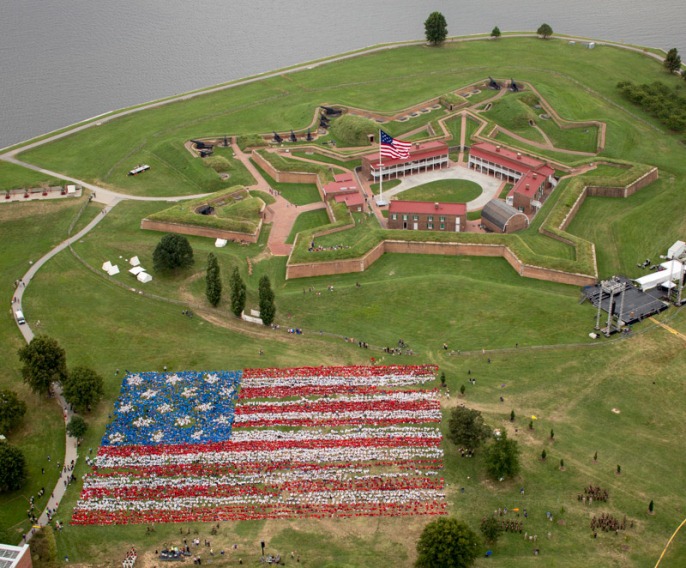Today we are sharing the first in a new series of posts from local preservationist Auni Gelles as she works on our new Battle of Baltimore website and soon-to-be-launched app. Auni tells the story of the city’s first Defender’s Day celebration and shares how we are carrying on this legacy of commemoration and education two centuries later.
Since 1815, Baltimoreans have celebrated the bravery of those “Old Defenders” who guarded against the British at sea (at Fort McHenry) as well as on land (at North Point) during the September 1814 Battle of Baltimore. This battle, near the end of the War of 1812, had implications for defense, trade, and perhaps most significantly, the identity of our city and country. The Americans’ success in Baltimore inspired Maryland attorney Francis Scott Key to write “The Defence of Fort M’Henry”—which we know today as our national anthem, The Star-Spangled Banner. Key’s lines, which gained near-instant popularity, transformed the flag from a straightforward military sign into a symbol of American patriotism. The event quickly became an integral part of the city’s understanding of itself in the new republic.

This September will mark 201st anniversary of the Battle and the the 200th anniversary of the city’s the first Defenders’ Day commemorations. Baltimore marked first anniversary of the battle with a ceremony that laid the cornerstone for the Battle Monument—a symbol has appeared on the city seal since its completion in 1825. Anniversaries of this major Battle presented an opportunity for Baltimoreans to recall their city’s moment of national importance. 19th century Baltimoreans celebrated Defenders’ Day annually with parades, artillery salutes, fireworks, speeches, banquets, performances, and, until the last veteran passed away in 1894, reunions of the Old Defenders. President Benjamin Harrison was in attendance for the 75th anniversary in 1889 and witnessed a 15,000-person parade, battle reenactments, and a rendition of The Star-Spangled Banner performed by a 415-piece band and a chorus 500 voices strong. The week-long centennial celebration in 1914 featured an “auto parade,” a carnival of electric lights, a military ball, an outdoor concert, fireworks over Fort McHenry, a display of visiting ships in the harbor, and schoolchildren forming form a human flag (sound familiar?).

The team at Baltimore Heritage is developing a new platform for exploring the Battle of Baltimore and its legacy, thanks to a grant from the Maryland Heritage Areas Authority. A new website and smart phone app will share short place-based stories related to the battle and its revered place in the city’s history. Like Explore Baltimore Heritage, the Battle of Baltimore website will use the Curatescape platform to plot these sites on a map and integrate individual stories into thematic tours. Some of the buildings integral to city life in and around 1814 are no longer extant, but we will seek to tell those stories with period illustrations and excerpts from 19th century publications.
As a graduate student in public history at UMBC, I will assisting with researching, writing, editing/formatting and publishing these stories for my thesis. I will also create blog posts as well as activities for engagement with this content, such as quizzes, lists, and shareable graphics.
Do you have questions about the project? Suggestions for sites to highlight? We’d love to hear your feedback!
Be sure to check out Auni’s 2014 post for the National Museum of American History with the story behind a modest piece of charred timber set on fire by British troops in 1814. You can also follow Auni on Twitter @aunigelles and share your comments on this post in the Bmore Historic Facebook group.


I love the addition of the historic and current photos, rounds out the information